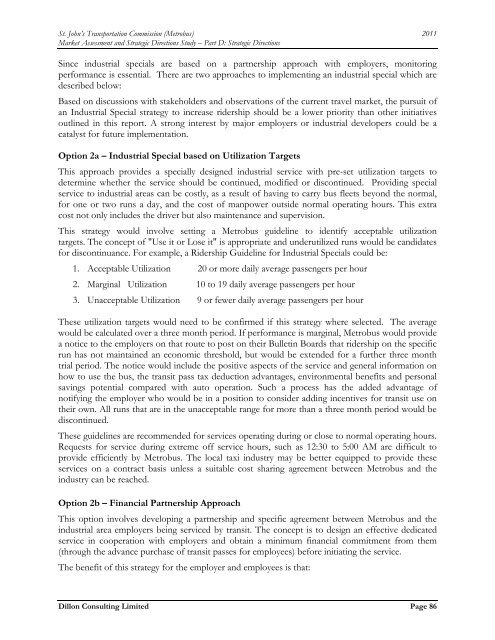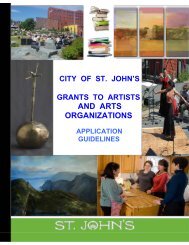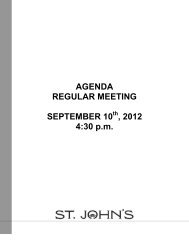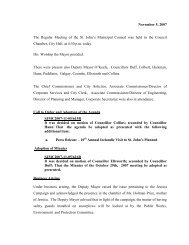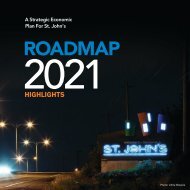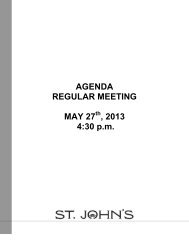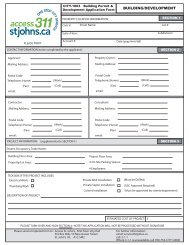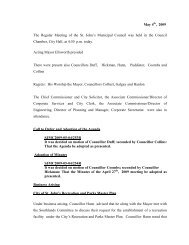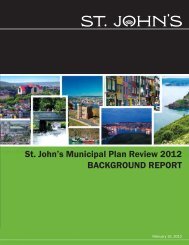Metrobus Transit Study.pdf - City of St. John's
Metrobus Transit Study.pdf - City of St. John's
Metrobus Transit Study.pdf - City of St. John's
Create successful ePaper yourself
Turn your PDF publications into a flip-book with our unique Google optimized e-Paper software.
<strong>St</strong>. John’s Transportation Commission (<strong>Metrobus</strong>) 2011<br />
Market Assessment and <strong>St</strong>rategic Directions <strong><strong>St</strong>udy</strong> – Part D: <strong>St</strong>rategic Directions<br />
Since industrial specials are based on a partnership approach with employers, monitoring<br />
performance is essential. There are two approaches to implementing an industrial special which are<br />
described below:<br />
Based on discussions with stakeholders and observations <strong>of</strong> the current travel market, the pursuit <strong>of</strong><br />
an Industrial Special strategy to increase ridership should be a lower priority than other initiatives<br />
outlined in this report. A strong interest by major employers or industrial developers could be a<br />
catalyst for future implementation.<br />
Option 2a – Industrial Special based on Utilization Targets<br />
This approach provides a specially designed industrial service with pre-set utilization targets to<br />
determine whether the service should be continued, modified or discontinued. Providing special<br />
service to industrial areas can be costly, as a result <strong>of</strong> having to carry bus fleets beyond the normal,<br />
for one or two runs a day, and the cost <strong>of</strong> manpower outside normal operating hours. This extra<br />
cost not only includes the driver but also maintenance and supervision.<br />
This strategy would involve setting a <strong>Metrobus</strong> guideline to identify acceptable utilization<br />
targets. The concept <strong>of</strong> "Use it or Lose it" is appropriate and underutilized runs would be candidates<br />
for discontinuance. For example, a Ridership Guideline for Industrial Specials could be:<br />
1. Acceptable Utilization 20 or more daily average passengers per hour<br />
2. Marginal Utilization 10 to 19 daily average passengers per hour<br />
3. Unacceptable Utilization 9 or fewer daily average passengers per hour<br />
These utilization targets would need to be confirmed if this strategy where selected. The average<br />
would be calculated over a three month period. If performance is marginal, <strong>Metrobus</strong> would provide<br />
a notice to the employers on that route to post on their Bulletin Boards that ridership on the specific<br />
run has not maintained an economic threshold, but would be extended for a further three month<br />
trial period. The notice would include the positive aspects <strong>of</strong> the service and general information on<br />
how to use the bus, the transit pass tax deduction advantages, environmental benefits and personal<br />
savings potential compared with auto operation. Such a process has the added advantage <strong>of</strong><br />
notifying the employer who would be in a position to consider adding incentives for transit use on<br />
their own. All runs that are in the unacceptable range for more than a three month period would be<br />
discontinued.<br />
These guidelines are recommended for services operating during or close to normal operating hours.<br />
Requests for service during extreme <strong>of</strong>f service hours, such as 12:30 to 5:00 AM are difficult to<br />
provide efficiently by <strong>Metrobus</strong>. The local taxi industry may be better equipped to provide these<br />
services on a contract basis unless a suitable cost sharing agreement between <strong>Metrobus</strong> and the<br />
industry can be reached.<br />
Option 2b – Financial Partnership Approach<br />
This option involves developing a partnership and specific agreement between <strong>Metrobus</strong> and the<br />
industrial area employers being serviced by transit. The concept is to design an effective dedicated<br />
service in cooperation with employers and obtain a minimum financial commitment from them<br />
(through the advance purchase <strong>of</strong> transit passes for employees) before initiating the service.<br />
The benefit <strong>of</strong> this strategy for the employer and employees is that:<br />
Dillon Consulting Limited Page 86


